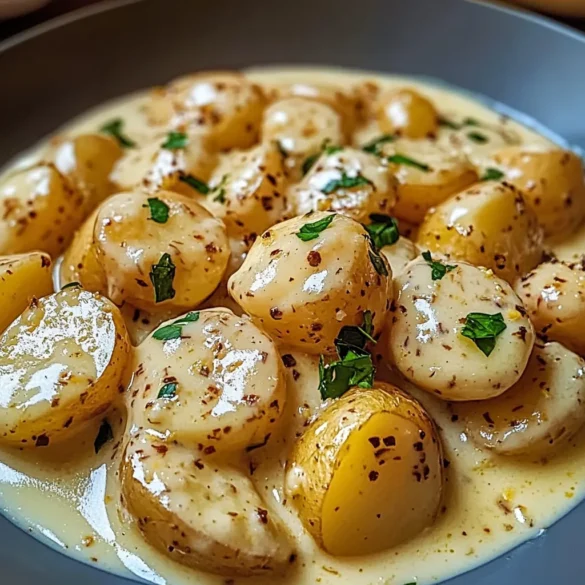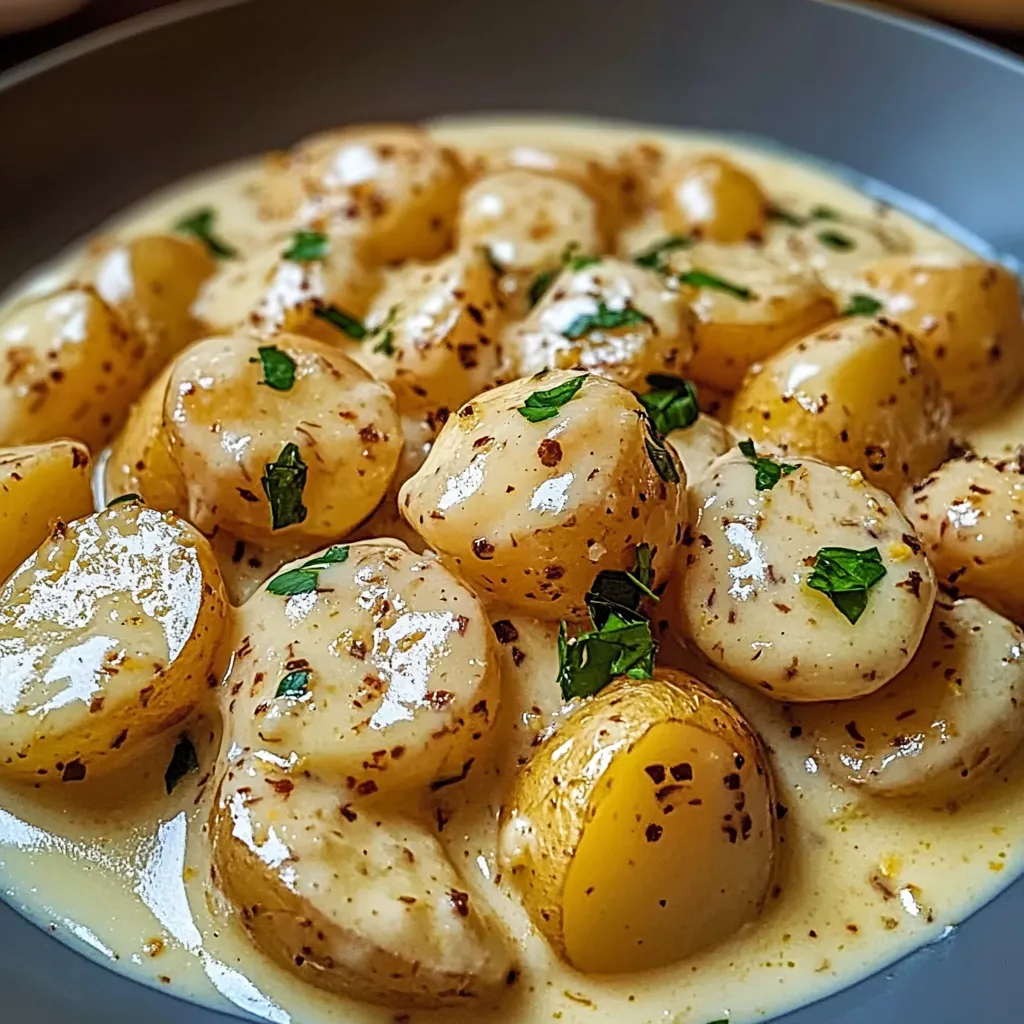These irresistible Creamy Garlic Sauce Baby Potatoes transform simple new potatoes into an elegant, restaurant-quality side dish with their perfect balance of crispy golden exteriors and luxuriously creamy garlic sauce. The recipe showcases tender baby potatoes seared to perfection, then bathed in a velvety garlic cream sauce that clings beautifully to each potato while maintaining just the right consistency. Every bite delivers an exquisite harmony—the potatoes develop gorgeous caramelized surfaces that contrast beautifully with their fluffy interiors, while the aromatic garlic sauce provides rich, savory depth that elevates the humble potato to gourmet status. The dish’s visual appeal of glossy, herb-flecked potatoes glistening in their creamy bath makes them as enticing to the eye as they are to the palate. This versatile comfort food exemplifies elevated home cooking at its finest—ideal for holiday dinners, special occasions, weeknight elegance, or anytime you crave a sophisticated side dish that effortlessly brings together simple ingredients in an impressive, crowd-pleasing presentation.
Why You’ll Love This Recipe
- Perfect texture contrast: Combines crispy, caramelized potato exteriors with creamy sauce
- Restaurant-quality results: Achieves professional flavors and presentation at home
- Quick preparation: Ready in under 30 minutes from start to finish
- Elegant presentation: Transforms simple potatoes into sophisticated side dish
- Versatile pairing: Complements everything from roasted meats to grilled fish
- Make-ahead friendly: Components can be prepared separately for easy assembly
- Crowd-pleasing appeal: Satisfies both comfort food lovers and gourmet enthusiasts
- Simple ingredients: Uses pantry staples to create extraordinary results
- Holiday-worthy: Perfect for special occasions and entertaining guests
- Customizable flavors: Easily adapts to different herbs and seasoning preferences
Ingredients
For the Baby Potatoes
- Baby potatoes (fingerling or new potatoes) – Provide tender, creamy texture with thin skins
- Olive oil – Creates golden searing and prevents sticking
- Butter – Adds rich flavor and enhances browning
- Salt and black pepper – Season potatoes and enhance natural flavors
- Fresh thyme sprigs – Contribute earthy, aromatic notes during cooking
For the Creamy Garlic Sauce
- Fresh garlic cloves – Deliver robust, aromatic foundation for the sauce
- Butter – Creates rich base and helps develop garlic flavors
- All-purpose flour – Thickens sauce and provides body
- Heavy cream – Forms luxurious, velvety sauce base
- Chicken or vegetable broth – Adds depth and balances richness
- Parmesan cheese – Contributes nutty, salty complexity
- Fresh herbs (parsley, chives) – Add brightness and color
- White wine – Enhances sauce depth and adds acidity balance
- Dijon mustard – Provides subtle tang and flavor complexity
- Salt and white pepper – Season and brighten all flavors
Optional Enhancements
- Fresh rosemary – Add pine-like, aromatic complexity
- Lemon zest – Brighten rich sauce with citrus notes
- Roasted garlic – Create deeper, sweeter garlic flavor
- Cream cheese – Enhance sauce richness and stability
- White wine – Add sophisticated depth and acidity
- Fresh sage – Contribute earthy, slightly bitter contrast
- Shallots – Provide mild, sweet onion flavor
- Heavy cream alternatives – Use half-and-half for lighter version
- Different cheese varieties – Experiment with Gruyère or fontina
Step-by-Step Instructions
Preparing the Baby Potatoes
- Begin by selecting 2 pounds of small, uniform baby potatoes, choosing ones that are roughly the same size (about 1-2 inches in diameter) for even cooking. Look for potatoes with smooth, unblemished skin and no green spots.
- Wash the potatoes thoroughly under cool running water, scrubbing gently with a vegetable brush to remove any dirt or debris. Pat completely dry with paper towels, as excess moisture will prevent proper browning during searing.
- If any potatoes are significantly larger than others, cut them in half to ensure uniform cooking times. Leave the skins on for added nutrition, color, and texture contrast in the finished dish.
- Place the clean, dry potatoes in a large pot and cover with cold water by about 1 inch. Add 1 tablespoon of salt to the water, which seasons the potatoes from within and helps them cook more evenly.
- Bring the water to a boil over high heat, then reduce to medium-high and cook for 12-15 minutes, until the potatoes are just fork-tender but still hold their shape. They should yield slightly to pressure but not be completely soft.
- Drain the potatoes thoroughly in a colander and let them sit for 5 minutes to allow excess moisture to evaporate. This step is crucial for achieving crispy, golden surfaces when searing.
- If desired, gently flatten each potato slightly with the back of a fork or potato masher to create more surface area for browning, being careful not to break them apart completely.
Searing the Potatoes
- Heat 2 tablespoons of olive oil in a large, heavy-bottomed skillet over medium-high heat until the oil shimmers but doesn’t smoke. A cast iron or stainless steel pan works best for achieving proper browning.
- Carefully add the parboiled potatoes to the hot oil in a single layer, ensuring they don’t overlap. Work in batches if necessary rather than overcrowding, which would cause steaming instead of browning.
- Season the potatoes with ½ teaspoon salt and ¼ teaspoon black pepper, then let them cook undisturbed for 3-4 minutes to develop a golden-brown crust on the bottom side.
- Add 1 tablespoon of butter to the pan, allowing it to melt and foam around the potatoes. The butter adds richness and helps achieve beautiful golden browning while preventing the oil from burning.
- Carefully flip each potato using tongs or a spatula, then continue cooking for another 3-4 minutes until the second side is golden brown and crispy. Add a few fresh thyme sprigs during this time for aromatic flavor.
- Continue turning the potatoes every few minutes until all sides are golden brown and crispy, about 10-12 minutes total cooking time. The potatoes should have a beautiful caramelized exterior while remaining tender inside.
- Remove the seared potatoes from the pan and set aside on a warm plate, covering loosely with foil to keep warm while preparing the sauce.
Creating the Creamy Garlic Sauce
- In the same skillet (don’t clean it—those browned bits add flavor), reduce heat to medium and add 2 tablespoons of butter, allowing it to melt and foam while scraping up any caramelized bits from the potato searing.
- Add 4-5 cloves of minced garlic to the melted butter and sauté for 30-60 seconds until fragrant but not browned, stirring constantly to prevent burning, which would create bitter flavors in the sauce.
- Sprinkle 2 tablespoons of all-purpose flour over the garlic and butter, whisking constantly to create a smooth roux. Cook for 1-2 minutes to eliminate the raw flour taste while maintaining a pale color.
- Gradually add ½ cup of chicken or vegetable broth, whisking continuously to prevent lumps from forming. The mixture will thicken quickly, so work steadily to maintain a smooth consistency.
- Slowly pour in ¾ cup of heavy cream while whisking constantly, creating a smooth, velvety sauce base. Bring the mixture to a gentle simmer, then reduce heat to medium-low.
- Add 2 tablespoons of white wine (optional) and 1 teaspoon of Dijon mustard, whisking to incorporate. These ingredients add depth and complexity while balancing the richness of the cream.
- Season the sauce with ½ teaspoon salt, ¼ teaspoon white pepper, and a pinch of nutmeg. Simmer gently for 3-4 minutes until the sauce coats the back of a spoon, indicating proper thickness.
- Remove from heat and stir in ¼ cup of grated Parmesan cheese and 2 tablespoons of chopped fresh parsley, whisking until the cheese melts completely and the sauce is smooth and glossy.
Combining and Serving
- Return the seared potatoes to the skillet with the creamy garlic sauce, gently folding them into the sauce to coat evenly without breaking the crispy exteriors.
- Place the skillet over low heat for 2-3 minutes to warm the potatoes through and allow the flavors to meld together, stirring gently to distribute the sauce evenly.
- Taste and adjust seasonings as needed, adding more salt, pepper, or fresh herbs according to your preference. The sauce should be creamy, well-seasoned, and cling nicely to the potatoes.
- Transfer to a serving dish or serve directly from the skillet for rustic presentation. Garnish with additional fresh parsley, chives, or a light sprinkle of Parmesan cheese for visual appeal.
- Serve immediately while hot for the best contrast between the crispy potato exteriors and the warm, creamy sauce. The dish is best enjoyed fresh but can be kept warm for short periods.

Pro Tips
- Choose uniform-sized baby potatoes for even cooking and presentation
- Parboil potatoes until just tender to ensure creamy interiors
- Dry potatoes thoroughly after boiling for maximum browning potential
- Don’t overcrowd the pan when searing—work in batches if necessary
- Let potatoes develop golden crust before flipping for best texture
- Use the same pan for sauce to capture flavorful browned bits
- Whisk constantly when adding liquids to prevent lumpy sauce
- Cook roux briefly to eliminate raw flour taste without browning
- Add cream gradually while whisking for smooth sauce consistency
- Simmer sauce gently to prevent breaking or curdling
- Remove from heat before adding cheese to prevent graininess
- Taste and adjust seasoning throughout cooking process
- Use fresh garlic for best flavor—avoid pre-minced versions
- Fresh herbs add brightness that complements rich sauce
- Serve immediately for optimal texture contrast
- Keep sauce at serving consistency—add broth if too thick
- Don’t skip the wine—it adds important flavor depth
- Use heavy cream for richest, most stable sauce
- White pepper maintains sauce’s pale color better than black
- Fresh thyme during searing adds subtle aromatic complexity
Variations and Creative Ideas
Herb Variations
- Mediterranean Herb Blend: Replace basic herbs with a mixture of fresh oregano, basil, and rosemary, adding a touch of lemon zest to the sauce for a bright, Mediterranean-inspired variation that pairs beautifully with grilled lamb or chicken.
- French Herb Elegance: Incorporate fresh tarragon, chervil, and chives into the sauce, creating a sophisticated French-inspired flavor profile that’s perfect for special occasions and pairs excellently with roasted meats and fish.
- Garden Fresh Medley: Use a combination of whatever fresh herbs you have available—parsley, dill, sage, and thyme work particularly well together, creating a bright, garden-fresh flavor that celebrates seasonal herb availability.
- Rustic Rosemary Focus: Feature fresh rosemary as the primary herb, both during potato searing and in the final sauce, creating an aromatic, pine-like flavor that’s especially appealing during fall and winter months.
Sauce Adaptations
- Lighter Cream Alternative: Replace heavy cream with a mixture of half-and-half and Greek yogurt (added off heat), reducing calories while maintaining creaminess and adding a subtle tangy note that complements the garlic beautifully.
- Cheese Lover’s Version: Incorporate multiple cheeses—Gruyère, fontina, and Parmesan—into the sauce for complex, nutty flavors that create an ultra-rich, restaurant-quality side dish perfect for special celebrations.
- Wine-Forward Sophistication: Increase white wine quantity and add a splash of cream sherry, reducing the liquid slightly longer to concentrate flavors and create a more complex, sophisticated sauce with deeper taste layers.
- Lemon Garlic Brightness: Add fresh lemon juice and zest to the finished sauce, creating a brighter, more acidic variation that cuts through richness and pairs exceptionally well with seafood and poultry dishes.
Potato Variations
- Mixed Potato Medley: Combine different varieties of small potatoes—red, yellow, and purple—for visual interest and subtle flavor differences that create a more dynamic and colorful presentation on the plate.
- Smashed Potato Style: After parboiling, lightly smash each potato to create more surface area for browning and sauce adherence, resulting in crispier textures and more sauce absorption for enhanced flavor in every bite.
- Roasted Potato Method: Skip parboiling and roast halved potatoes at 425°F until crispy and golden, then toss with the creamy sauce for a different texture approach that emphasizes caramelized, crispy surfaces.
- Fingerling Showcase: Use specifically fingerling potatoes for their unique shapes and creamy textures, highlighting their natural beauty while the creamy sauce enhances their delicate, buttery flavor profile.
Global Flavor Inspirations
- Italian Inspired: Add sun-dried tomatoes, fresh basil, and extra Parmesan to create an Italian-influenced variation that pairs beautifully with osso buco, chicken parmigiana, or other Mediterranean main courses.
- French Bistro Style: Incorporate Dijon mustard more prominently, add caramelized shallots, and finish with fresh tarragon for an authentic French bistro flavor that elevates simple ingredients to restaurant-quality sophistication.
- Spanish Influence: Add smoked paprika, saffron, and a touch of sherry vinegar to create a Spanish-inspired variation with warm, complex flavors that complement paella, grilled seafood, or roasted pork dishes.
- German Comfort: Include caraway seeds, fresh dill, and a touch of sour cream (added off heat) for a German-inspired variation that pairs wonderfully with bratwurst, schnitzel, or other hearty Central European dishes.
Frequently Asked Questions
How do I prevent the sauce from breaking or curdling?
Sauce stability depends on careful temperature control and proper technique. Always remove the pan from heat before adding cheese, and whisk constantly when incorporating dairy products. If the sauce does break, try whisking in a tablespoon of cold cream or butter off the heat. To prevent issues, avoid high heat once cream is added, and ensure your roux is properly cooked before adding liquids gradually while whisking continuously.
Can I make this dish ahead of time?
While best served immediately, you can partially prepare components in advance. Parboil and sear potatoes up to 2 hours ahead, keeping them at room temperature. Prepare the sauce base (through adding cream) and refrigerate separately. To serve, gently reheat the sauce, thinning with a little broth if needed, then warm the potatoes in the sauce just before serving. The textures won’t be quite as perfect as when freshly made, but it’s still delicious.
What’s the best way to reheat leftovers?
Reheat gently in a skillet over low heat, adding a splash of cream or broth to restore sauce consistency. Alternatively, warm in a 300°F oven covered with foil for about 15 minutes. Avoid microwaving if possible, as it can make the potatoes rubbery and cause the sauce to separate. Stir gently and taste for seasoning, as flavors may need refreshing with a bit of fresh herbs or a squeeze of lemon juice.

Ingredients
For the Baby Potatoes:
2 pounds baby potatoes (uniform size)
2 tablespoons olive oil
1 tablespoon butter
½ teaspoon salt
¼ teaspoon black pepper
2-3 fresh thyme sprigs
1 tablespoon salt (for boiling water)
For the Creamy Garlic Sauce:
2 tablespoons butter
4-5 garlic cloves, minced
2 tablespoons all-purpose flour
½ cup chicken or vegetable broth
¾ cup heavy cream
2 tablespoons white wine (optional)
1 teaspoon Dijon mustard
¼ cup Parmesan cheese, grated
2 tablespoons fresh parsley, chopped
½ teaspoon salt
¼ teaspoon white pepper
Pinch of nutmeg
For Garnish:
Additional fresh parsley or chives
Extra Parmesan cheese (optional)
Fresh thyme sprigs
Cracked black pepper
Instructions
Wash and prepare 2 pounds uniform baby potatoes. Boil in salted water 12-15 minutes until just tender.
Drain thoroughly and let sit 5 minutes to dry. Optional: lightly flatten for more browning surface.
Heat olive oil in large skillet over medium-high heat. Add potatoes in single layer.
Season with salt and pepper. Sear 3-4 minutes per side until golden brown all over.
Add butter and thyme sprigs during searing for enhanced flavor and browning.
Remove potatoes and keep warm. In same skillet, melt 2 tablespoons butter over medium heat.
Add minced garlic and sauté 30-60 seconds until fragrant but not browned.
Whisk in flour to create roux. Cook 1-2 minutes to eliminate raw flour taste.
Gradually add broth while whisking, then slowly add cream, maintaining smooth consistency.
Add wine and Dijon mustard. Simmer 3-4 minutes until sauce coats spoon.
Remove from heat. Stir in Parmesan and parsley until smooth.
Return potatoes to sauce, warm gently 2-3 minutes. Serve immediately with garnishes.
Notes
Choose uniform baby potatoes for even cooking and presentation
Dry potatoes thoroughly after boiling for maximum browning
Don't overcrowd pan when searing—work in batches if needed
Let potatoes develop golden crust before flipping for best texture
Use same pan for sauce to capture flavorful browned bits
Whisk constantly when adding liquids to prevent lumps
Remove from heat before adding cheese to prevent graininess
Adjust sauce consistency with broth if too thick
Taste and adjust seasoning throughout cooking process
Serve immediately for optimal texture contrast
Use fresh garlic for best flavor—avoid pre-minced versions
Fresh herbs add brightness that complements rich sauce
Don't skip parboiling step—ensures creamy potato interiors
Control heat carefully once cream is added to prevent breaking
White pepper maintains sauce's attractive pale color
Optional wine adds important depth and complexity
Keep sauce at gentle simmer to maintain smooth consistency
Fresh thyme during searing adds subtle aromatic notes
Properly cooked roux is key to smooth, lump-free sauce
Garnish just before serving for best visual appeal

